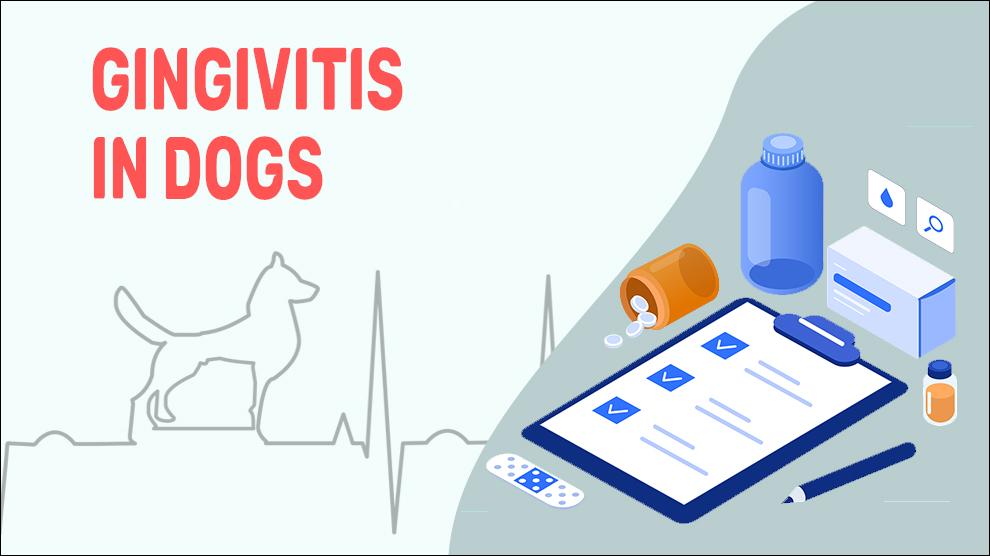What Is Gingivitis In Dogs?
Gingivitis is a mild, early form of periodontal disease that results due to bacterial buildup and subsequent infection.
More than 75% of dogs have some sort of dental disease by the time they are three years old. Gingivitis is simply called ‘inflammation of gums’. Gingivitis s considered to be a first warning sign of imminent periodontal disease.
Whenever a dog consumes its food, the chewing process (breakdown of carbohydrates) leaves behind the sticky substance known as dental plaque. Dental plaque is an active, complex biofilm of the extremely heterogeneous and poly-microbial community (interactive microenvironment) that grow in a mass of exopolysaccharides-alled plaque matrix. This colorless/pale yellow deposit of biofilm changes from a gummy texture to a harder product within 24 hours of consumption of the meal.
In its starting stages, the plaque is mostly organic and it is made up of bacteria, mineral salts, organic matter, food particles, and serum. The precipitation of calcium phosphate salts within the organic matrix adheres to the teeth, gets harder, and calcified. When the dental plaque hardens, tartar is formed just at or above the gum margins (supragingival) and forms below the gum line on the surfaces of the tooth root (subgingival). Tartar (dental calculus) is inorganic (70–80%) and primarily consists of calcium and phosphorus with minor components of sodium, carbonate, magnesium, fluoride, iron, and silicon.
Tartar buildup can lead to infection, inflammation (gingivitis), periodontal disease, and even loss of teeth. Most commonly, plaque-associated gingivitis is found as edematous, erythematous tissue that halos the teeth.
Symptoms Of Gingivitis In Dogs
- Bleeding gums
- Red or swollen gums
- Bad breath (halitosis)
- Difficulty or pain with chewing
- Pus/mucous along the gum line, in nasal discharge
- Loss of appetite
- Lethargy
Treatment Options For Gingivitis In Dogs
- The dental cleaning procedure includes a complete dental examination, after that a dental scaling using traditional hand scalers and ultrasonic cleaning equipment to scrape off the plaque and tartar from the surfaces of the tooth. cleaning under anesthesia is recommended to be done twice a year.
- Gingival curettage is the removal of infected, inflamed, necrotic, or damaged tissue from the periodontal pocket.
- Application of antibiotic medications to resolve gum infections.
- Gingivectomy- Removal of excessive gingival tissues.
- Gingivoplasty – Elimination of diseased soft tissue from the wall of a periodontal pocket and recontouring of the gum tissue.
- Periodontal surgery – A procedure performed for deeper cleaning and treatment of the root of the tooth by opening the gum to expose the tooth. Bone growth stimulants, Slow-release antibiotics, and sealants will be added to encourage attachment and healing.
Home Remedies For Gingivitis In Dogs
With gentleness and patience, always provide the required oral care your dog needs to prevent dental diseases.
Don’t skip routine dental checkups and Consult with your vet for guidance on teeth brushing tips.
How To Prevent Gingivitis In Dogs?
- The simple way to prevent gingivitis is to prevent plaque/tartar accumulation.
- Use pet-safe enzymatic toothpaste that is specially formulated for dogs at least 2-4 times each week.
- Dental wipes, chew toys for dogs, treats or oral rinse may also help decrease or delay plaque/tartar.
- Exclusively formulated pet foods are used as dental diets with proven tartar-reducing ingredients. Water additives interfere with plaque development.
- Confirm with the Veterinary Oral Health Council website for products listed for plaque control to reduce the accumulation of plaque and/or tartar.
Affected Dog Breeds Of Gingivitis
There is no breed disposition.
Boxer, Mastiff, Great Dane, Bulldog, Collie, Shih Tzu
Causes And Types For Gingivitis In Dogs
1. Causes:
- The dominant bacterial species in dental plaque are Fusobacteriumcanifelinum and Porphyromonas crevioricanis.
- The most common genus belongs to Porphyromonas, Fusobacterium, and Capnocytophaga.
2. Types:
To determine the severity of periodontal disease in dogs, Vets have a separate grading scale.
The scale ranges from 0 to 4
- Stage 0: Gums are pink and flat, teeth are clean
- Stage 1: Subtle signs, inflammation of the gums (Gingivitis) - alveolar margins appear normal, No attachment loss to teeth supporting structures.
- Stage 2: Starting stage periodontitis - < 25% of the tooth’s attachment to the supporting structures is lost (measured by Dental x-rays or clinical probing).
- Stage 3: Intermediate periodontitis - 25% -50% of the tooth’s attachment to supporting structures is lost.
- Stage 4: Advanced periodontitis - > 50% tooth support is lost.
3. Mortality:
There is no mortality associated with gingivitis documented yet.
4. Diagnosis:
- Routine dental exam
- Dental X-rays
5. Prognosis:
Dogs with Stage 1 and Stage 2 periodontal disease prognoses are good as long as they receive the appropriate dental care. Also, the prognosis of Stage 3 dogs is fair when advanced dental procedures are performed. In Stage 4 of periodontal disease, the prognosis is poor when greater than 50% of the tooth’s attachments are lost.
When To See A Vet For Gingivitis In Dogs?
Time to visit the vet clinic for an examination, if you notice any of the following:
- Bad breath (halitosis)
- Bleeding/ Red or swollen gums
Food Suggestions For Gingivitis In Dogs
Foods to eat:
- Foods with fluoride including dehydrated soups
- Fiber-rich fruits and vegetables
- Bones (raw, not cooked), cooked chicken giblets (hearts, liver, gizzards)
- Cheese, milk, plain yogurt, and other dairy products
- Dental diet-approved kibble and treats
Foods to avoid:
- Starchy foods that can get stuck in the mouth
- Chewy, sticky, and hard candy
- Crackers, Popcorn
- Rice and potato-based dental sticks
Conclusion
The prevention of dental plaque accumulation should be given top priority because it can lead to gingivitis and periodontal disease. They not only affect the oral health of dog but the infection may be transported through the bloodstream to all parts of the body and can cause other systemic problems.

















